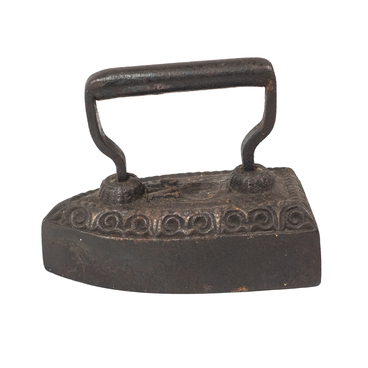The first irons appeared in ancient times. In the 4th century BC in Ancient Greece, clothes were smoothed using a hot metal rod, which resembled a rolling pin. Lightly processed heated cobblestones were also used. In the 18th and 19th centuries, irons already had a shape close to the modern one.
Steam iron with pipe
Creation period
First half of the 20th century
Dimensions
20.5 cm x 20 cm x 12.5 cm
Technique
Cast iron, wood, casting, turning
Collection
8
Open in app#1
Steam iron with pipe
#8
#15
In Russia, irons began to be used in the early 17th century. Prior to this, clothes were wound on a rolling pin, after which they were carefully rolled several times with a rubel: a long wooden plate with ridges on the lower surface and a handle at the end. This ironing technique was preserved in some villages until the late 20th century.
#16
The 17th century saw the advent of irons with an opening case, inside of which burning coals were placed. There was a handle on top of the iron and small holes on the sides. Some models had a pipe, which provided stronger traction. During ironing, the iron was moved back and forth, increasing ventilation, and, therefore, heating.
#17
The bottom of a coal iron cooled down rather slowly. To prevent the coals from cooling down quickly, they blew into the side holes, fanning the coals, and sometimes they waved the iron in different directions, although it was very heavy. To make the sole heat evenly, a special grate was placed under the coals inside. Steam irons were much more convenient than braziers, although they often lost embers that could ruin the fabric.
#18
Irons could be bought at fairs. Trade was actively developing in Nevyansk in the 19th century. Big fairs were organized twice a year: in the summer, in late June, the Petrovskaya fair was held, and in winter, in late December, the Aleksandro-Nikolaevskaya fair. Markets took place weekly, on Sundays. On these days, the market square of Nevyansk was dotted with numerous stands. On the right bank of the Neyva River, there were bakery and butcher stalls, dubbed ‘the gluttony aisle.’ Not only residents of the surrounding villages came here to buy and sell their goods, but also traders from many cities of the Urals, Siberia and Central Russia. Successful trade was facilitated by the convenient location of Nevyansk, between Yekaterinburg and the Nizhniy Tagil plant, as well as by the presence of the Siberian Railway and the Ural Mining Railway, which connected Nevyansk with the Urals and Western Siberia.
#19
State Autonomous Cultural Institution of the Sverdlovsk Region "Nevyansk State Historical and Architectural Museum"
read morehide
00:00
00:00
1x
Steam iron with pipe
Creation period
First half of the 20th century
Dimensions
20.5 cm x 20 cm x 12.5 cm
Technique
Cast iron, wood, casting, turning
Collection
8
Open in app
Share

